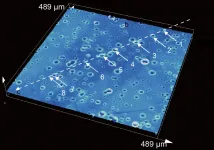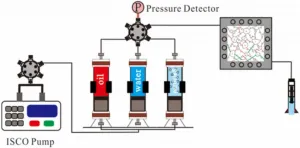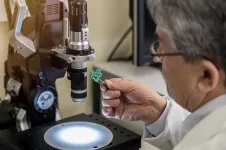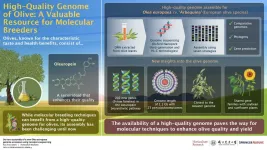New material could remove respiratory droplets from air
'Every droplet effectively removed from indoor air would eliminate a potential source of transmission'
2021-06-16
(Press-News.org) Although plexiglass barriers are seemingly everywhere these days -- between grocery store lanes, around restaurant tables and towering above office cubicles -- they are an imperfect solution to blocking virus transmission.
Instead of capturing virus-laden respiratory droplets and aerosols, plexiglass dividers merely deflect droplets, causing them to bounce away but remain in the air. To enhance the function of these protective barriers, Northwestern University researchers have developed a new transparent material that can capture droplets and aerosols, effectively removing them from air.
The material is a clear, viscous liquid that can be painted onto any surface, including plastic, glass, wood, metal, stainless steel, concrete and textiles. When droplets collide with the coated surface, they stick to it, get absorbed and dry up. The coating also is compatible with antiviral and antimicrobial materials, so sanitizing agents, such as copper, could be added to the formula.
"Droplets collide with indoor surfaces all the time," said Northwestern's Jiaxing Huang, the study's senior author. "Right now, plexiglass dividers are deviating devices; they deflect droplets. If a surface could actually trap droplets, then every single droplet effectively removed from indoor air would be a successful elimination of a potential source of transmission."
The research will be published Wednesday (June 16) in the journal Chem. In the study, the researchers found that even when they bombarded surfaces with aerosol droplets -- at orders of magnitude higher concentration than typical for an indoor environment -- the coated surfaces still captured three times more aerosol droplets than uncoated surfaces.
Huang is a professor of materials science and engineering in Northwestern's McCormick School of Engineering. Zhilong Yu, Murak Kadir and Yihan Liu -- all members of Huang's laboratory -- co-authored the paper. The team embarked on this project during the stay-at-home order at the beginning of the pandemic.
The main ingredient in the Northwestern team's material is a polyelectrolyte polymer that is commonly used in a wide variety of cosmetic products. When applied with a blade or brush, the resulting formula yields uniform and conformal coatings on a broad range of indoor surfaces without damaging or discoloring the original material.
Huang's team found the surfaces also remained transparent and haze-free even when doused with droplets. In other words, the surfaces did not appear filthy or soiled after being showered with droplets. If used on plexiglass barriers, those coated barriers would not need to be cleaned more frequently than uncoated barriers.
Most infectious diseases spread through respiratory droplets and aerosols, which humans release constantly when talking, laughing, singing and exhaling. Because the coating is so versatile, Huang imagines that it could be used on plexiglass barriers and face shields as well as on no-touch or low-touch surfaces, such as walls or even curtains, to eliminate those droplets from the air.
"There are massive areas of indoor surfaces that are barely touched by people or pets. If we repurposed these 'idling' surfaces to capture respiratory droplets, then they could become functional 'devices' to help reduce air-borne transmission of infectious diseases," he said. "Surface-trapped pathogens can then be readily inactivated over time, which can be accelerated by pre-applied sanitization ingredients. They also can be removed during routine cleaning."
While Huang says that face masks are an irreplaceable public health tool to help preventing the spread of infectious droplets, he believes that trapping droplets on surfaces could be another effective tool.
"In a computer game, for example, you don't want to walk into a battlefield with only one piece of armor," he said. "It makes sense to leverage multiple layers of defense."
INFORMATION:
The study, "Droplet-capturing coatings on environmental surfaces based on cosmetic ingredients," was supported by a JITRI-Northwestern Research Fellowship awarded from Jiangsu Industrial Technology Research Institute, managed by the Northwestern Initiative for Manufacturing Science and Innovation.
[Attachments] See images for this press release:

ELSE PRESS RELEASES FROM THIS DATE:
2021-06-16
New York, NY (June 16, 2021) -- Immune cells that normally repair tissues in the body can be fooled by tumors when cancer starts forming in the lungs and instead help the tumor become invasive, according to a surprising discovery reported by Mount Sinai scientists in Nature in June.
The researchers found that early-stage lung cancer tumors coopt the immune cells, known as tissue-resident macrophages, to help invade lung tissue. They also mapped out the process, or program, of how the macrophages allows a tumor to hurt the tissues the macrophage normally repairs. This process allows the tumor to hide from the immune system and proliferate into later, deadly stages of cancer.
Macrophages play a key ...
2021-06-16
June 16, 2021, CLEVELAND: New findings from Cleveland Clinic researchers show for the first time that the gut microbiome impacts stroke severity and functional impairment following stroke. The results, published in Cell Host & Microbe, lay the groundwork for potential new interventions to help treat or prevent stroke.
The research was led by Weifei Zhu, Ph.D., and Stanley Hazen, M.D., Ph.D., of Cleveland Clinic's Lerner Research Institute. The study builds on more than a decade of research spearheaded by Dr. Hazen and his team related to the gut microbiome's role in cardiovascular health and disease, including the adverse effects of TMAO (trimethylamine N-oxide) - a byproduct produced when gut bacteria digest certain nutrients abundant in red meat and other animal ...
2021-06-16
Our eyes move three times per second. Every time we move our eyes, the world in front of us flies across the retina at the back of our eyes, dramatically shifting the image the eyes send to the brain; yet, as far as we can tell, nothing appears to move. A new study provides new insight into this process known as "visual stabilization". The results are published in the Proceedings of the National Academy of Sciences.
"Our results show that a framing strategy is at work behind the scenes all the time, which helps stabilize our visual experience," says senior author Patrick Cavanagh, a research professor in psychological and brain sciences at Dartmouth ...
2021-06-16
A joint paper went out in Journal of Petroleum Science and Engineering.
Petroleum, being a liquid compound, has very good migratory properties, and recovery methods take account of that - using various methods, oilers displace petroleum through cavities and vugs and extract it. However, sometimes oil is "locked" in low-permeability reservoirs, and water displacement used in such cases poses a high risk of reservoir flooding and workplace emergencies.
Many teams work on blocking high-permeability areas in order to make extraction a more controlled and safe process. In particular, there have yet been no efficient agents for reservoirs with high temperatures (up to 140 C) and mineralization (up to 250 grams ...
2021-06-16
Professor Hermann Ehrlich places a piece of sponge in an alkaline, copper-containing ammonia solution that simulates a copper bath from the manufacture of circuit boards for electronic components. About 12 hours later the sponge has turned blue - when dry it is stronger than before, but still very light. "At a pH value of 9 the fibers of the spongin open and the organic compounds of the protein change," explains Prof. Hermann Ehrlich. The copper contained in the ammonia solution reacts immediately with the organic components of the spongin, especially with the amino acid residues, and forms the mineral atacamite. "Like a string, nanometer-sized crystals grow along with the spongin fiber," explains the scientist. ...
2021-06-16
Olives, well-known for their characteristic bitter taste, are in high demand owing to the popularity of the oil that's derived from them. The health benefits of olive oil are well known, ranging from antiviral, anti-cancer, to even anti-hypertensive effects. These benefits are attributed to "oleuropein," the most abundant olive secoiridoid found in olives.
An efficient method to enhance the quality of plant products is by using molecular methods to manipulate their genes and enhancing their yield. With olives, however, this is still a challenge, because of a lack of sufficient genome data.
So far, the genomes of two European olive varieties have been sequenced. But to fully decipher ...
2021-06-16
Lack of data on contraception uptake prior to the pandemic means no clear picture of the impact Covid-19 had on contraception use
Study from Warwick Medical School highlights need to maintain access to contraception during disasters
Researchers recommend making more contraception prescription-free and discuss the benefits and pitfalls of telehealth
Limited data on the uptake of contraception prior to and during crises such as the Covid-19 pandemic could mean unforeseen issues for sexual and reproductive health services, research from the University of Warwick concludes.
It identifies additional barriers that women faced in accessing contraception during the Covid-19 lockdown, including disruption to sexual health services and fears about contracting the virus, as ...
2021-06-16
New research shows the UK's COVID-19 management decisions were based on an outdated pandemic modelling structure and suggests a more resilient approach would have been more effective.
In the initial months of the pandemic, regular updates using graphs showing how the R number was behaving was the mainstay of the Government's strategy for tackling COVID-19.
This type of infection transmission is usually mathematically-based on dividing the population into 'compartments'. Such an approach has been criticised for its limited scope and inability to capture critical factors, such as the ...
2021-06-16
Results show BAT's Modern Oral nicotine pouches have a comparable toxicant profile to NRTs, which are currently considered the least risky of all nicotine products*†
The Modern Oral products have far fewer and significantly lower levels of toxicants‡ than cigarette smoke
Data demonstrates how BAT is building A Better Tomorrow™ by providing evidence to show how we are reducing the health impact of our business and delivering Tobacco Harm Reduction
London, 16 June: New research published today indicates that BAT's modern oral (MO) products in the form of tobacco-free nicotine pouches have a toxicant profile that is comparable to nicotine replacement therapies (NRTs) and much lower than traditional oral ...
2021-06-16
CHAPEL HILL, NC - UNC School of Medicine scientists led a collaboration of researchers to demonstrate a potentially powerful new strategy for treating cystic fibrosis (CF) and potentially a wide range of other diseases. It involves small, nucleic acid molecules called oligonucleotides that can correct some of the gene defects that underlie CF but are not addressed by existing modulator therapies. The researchers used a new delivery method that overcomes traditional obstacles of getting oligonucleotides into lung cells.
As the scientists reported in the journal Nucleic Acids Research, they demonstrated the striking effectiveness of their approach in cells derived from a CF patient and in mice.
"With our oligonucleotide delivery platform, we were able to restore the activity of ...
LAST 30 PRESS RELEASES:
[Press-News.org] New material could remove respiratory droplets from air
'Every droplet effectively removed from indoor air would eliminate a potential source of transmission'






